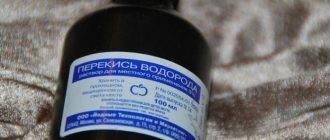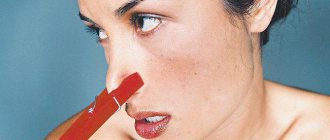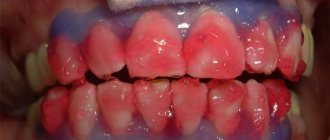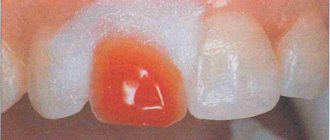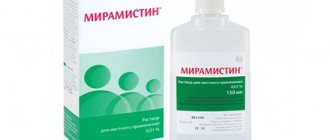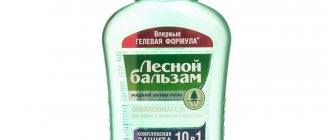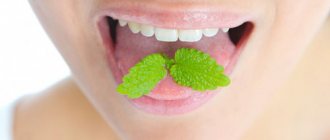About the benefits of tea tree oil
Tea tree oil, or Melaleuca as it is also called, is extracted from the leaves of the Australian plant Melaleuca alternifolia.
A plant called melaleuca is widespread on the Australian continent. It is from this that tea tree oil, known for its healing properties, is obtained. It has been used for dental treatment and oral care for many years. But the scope of tea tree use is not limited to dentistry.
https://www.youtube.com/watch?v=LFpDiiVAHwY
This plant is in demand in gynecology, modern cosmetology, and in the treatment of inflammatory diseases and colds. Its oil has many healing properties. It can have antiseptic, bactericidal, anti-inflammatory and antifungal effects. In addition, it has the ability to stimulate the immune system.
The effectiveness of tea tree against bacterial infections is associated with the presence of special substances in its composition - terpineols. They penetrate the cells of pathogenic microbes and kill them.
Treatment of the oral cavity with essential oil gives the following results:
- Teeth enamel becomes lighter in color
- Inflammation on the gums goes away
- The microflora of the mucous membrane is normalized
- Stops bothering you about bleeding
- Reduces the likelihood of tartar formation
- Reduces the risk of developing caries
- Breath becomes fresh
Tea tree oil gets rid of bacteria, improves the appearance of teeth. Most dental problems are associated with the action of pathogenic microorganisms. They also cause an unpleasant odor. Tea tree essential oil quickly helps get rid of harmful bacteria, improve the appearance of teeth and restore an attractive smile.
Description and composition of melaleuca oil
Tea tree oil has different compositions. It all depends on the tree whose leaves served as the raw material for the product.
- About half of melaleuca ester consists of monoterpenes.
- From 35% to 40% of its composition are diterpenes. The more there are, the more pronounced the healing properties are.
- From 3% to 15% is cineole. It can cause irritation of the skin, especially mucous membranes. At a concentration of less than 15%, it is safe even for sensitive skin, but for safety reasons, tea tree oil is still recommended to be diluted before use.
Tea tree oil is thick and practically insoluble in water. Even glycerin does not allow it to dissolve quickly and well. But any other cosmetic or simply vegetable oil copes well with this task. Most often, olive, almond, and avocado oils are used as base oils. 100% tea tree oil does not often go on sale: what you see on the shelves of pharmacies and specialty stores is a natural, but diluted product that has a concentration of 50% to 80%.
The recipes that you will find in this material assume the use of 100% ether. If you have a diluted product, increase its amount by 1.5-2 times.
The color of melaleuca essential oil can be almost clear, pale yellow-green, or olive.
The ether has a pronounced aroma, in which notes of myrtle and camphor are distinguishable. In the sillage, people with a sensitive sense of smell detect bitter and even fruity notes.
Paired with citrus, woody and spicy aromas, tea tree ether can create a good bouquet. To aromatize rooms, it is mixed with esters of clove, bergamot, lemon, bitter orange, and sandalwood.
Tea tree oil has not found wide use in the perfume industry, but in medicine and cosmetology it has proven to be in demand.
Treatment of bleeding
Tea tree has been successfully used to treat gum disease and quickly helps eliminate bleeding. If you encounter such a problem, you will need one of the following methods.
Applications
A small cotton swab is soaked in oil and applied to the gum for 10-15 minutes. Then perform a light massage of the gums. After the procedure, do not forget to rinse your mouth thoroughly with clean water. If your teeth are sensitive, this method will help you avoid discomfort. Ether (3 drops) is mixed with a teaspoon of aloe. The resulting mixture is rubbed into the gums with light movements.
Therapeutic rinses
Rinsing with tea tree oil daily will help with bleeding gums.
To combat gingivitis and bleeding, dentists recommend rinsing your mouth daily with an essential oil-based composition. The solution is prepared as follows: add 8-9 drops of oil to a glass of hot water.
By destroying pathogenic bacteria in the mouth, tea tree oil gives fresh breath, strengthens gums and has a beneficial effect on the condition of teeth (including preventing the formation of plaque and tartar).
To prepare a solution for rinsing the mouth for dental diseases and infectious-inflammatory diseases of the lymph-pharyngeal ring, for bad breath, add 5-7 drops of tea tree essential oil to 200 ml (1 glass) of warm water. It is recommended to rinse your mouth with this solution 2-3 times a day.
For fungal infections of the mouth and throat, 30-second rinses (2-3 times a day) of the mouth and throat with a solution that can be prepared by adding 3-4 drops of tea tree oil to 2 tablespoons of water will bring tangible benefits.
Rinsing with warm water with the addition of tea tree oil (1 drop of oil per 1 glass of water) will help give freshness to your breath.
For gingivitis, stomatitis, and bleeding gums, it is recommended to rinse the mouth with a solution that can be prepared by adding 8-10 drops of tea tree oil to 200 ml of warm water. After rinsing (twice a day) with this solution, it is advisable to treat the problem area with a mixture prepared from 1 teaspoon of tea tree oil and 1 tbsp. spoons of St. John's wort oil.
For stomatitis, periodontal disease, and bad breath, it is recommended to rinse the oral cavity 2-3 times a day with a solution prepared as follows: add 0.5-1 teaspoons of alcohol and 2-3 drops of tea tree essential oil.
To whiten your teeth, after brushing them with toothpaste, you need to rinse the brush under water, drop 2 drops of tea tree oil on it, brush your teeth again, and then rinse your mouth well with warm water. To eliminate dark plaque on teeth and prevent the formation of tartar, it is useful to rinse your mouth 3-4 times a day with water with the addition of tea tree oil (5 drops of this oil per 1 glass of water).
Applying a piece of cotton wool soaked in 2 drops of tea tree oil to the sore spot will help relieve toothache.
To prevent caries, it is useful to add 1 drop of tea tree essential oil to the toothpaste applied to your toothbrush, and also periodically treat your floss with this essential oil.
Promoting immunity, having bactericidal, anti-inflammatory and antiviral properties, tea tree oil has long been traditionally used in the treatment and prevention of colds and flu, which are accompanied by tonsillitis (acute tonsillitis), laryngitis, pharyngitis, rhinitis, otitis media, lung diseases and accompanying cough.
Arolamp with tea tree oil for the prevention of seasonal epidemics of ARVI: 10 drops of oil per 10 square meters of room area.
Anti-cold aromatic bath (1st recipe): mix 4 drops of tea tree oil and 1 drop each of fennel, chamomile and lemon essential oils with a small amount of shower gel and stir evenly in the bath.
Anti-cold aromatic bath (2nd recipe): 5 drops of tea tree oil, 2 tablespoons of table or sea salt, 1 tbsp. mix a spoonful of honey with 2 tbsp. spoons of cream and stir evenly in the bath.
Aromatic anti-inflammatory bath (1st recipe): 5 drops of tea tree essential oil and add 2 drops of lavender oil, dissolve in 2 tbsp. spoons of cream and stir evenly in the bath.
An anti-inflammatory aromatic bath (2nd recipe): dissolve 4 drops of tea tree essential oil, 1 drop of sage oil, 2 drops of anise oil in 2 tbsp. spoons of cream and stir evenly in the bath.
“Hot” inhalation: pour 2 liters of hot water into a pan, add 2 drops of tea tree oil and 2 drops of essential eucalyptus oil and deeply inhale the steam for 8-10 minutes (inhale water vapor during this inhalation with your eyes closed, covering your head with a towel) .
“Cold” inhalation: apply 7-8 drops to a handkerchief and inhale the aroma emanating from the handkerchief throughout the day. At night, apply a few drops of tea tree oil to your pillow.
For tonsillitis, pharyngitis, laryngitis, add 5-7 drops of tea tree oil to 100 ml (0.5 cups) of warm water and gargle with this solution 2-3 times a day. After rinsing, do not eat or drink anything for 30-40 minutes.
For a runny nose (rhinitis), sinusitis, sinusitis and nasal congestion, rub tea tree oil into the wings of the nose, the bridge of the nose and from the inside into the nasal passages.
We suggest you read: Tonsil plugs are they contagious?
For rhinitis, instill into the nose a mixture consisting of 5-10 ml of basic vegetable oil (can be sunflower or olive), 1 drop of lavender and 1 drop of tea tree oil.
For nasal congestion, it is also useful to inhale the aroma emanating from a glass of hot water to which 3-4 tea tree oils have been added.
For otitis media and ear pain, instill a mixture of 10 drops of olive (or almond) oil and 2 drops of tea tree essential oil into the ears.
For bronchitis, inhale with tea tree oil (see the inhalation recipe above), then rub your chest with 5 drops of tea tree oil and place a hot water bottle wrapped in a towel on your chest for 1 hour.
For a cold cough, it is useful to inhale before going to bed by adding 2-3 drops of tea tree oil to the inhaler or breathing for 8-10 minutes over a pan of hot water to which 5 drops of this oil have been added (inhale water vapor during such inhalation with your eyes closed, covering head with a towel).
1) Mix 1 teaspoon of tea tree oil with 1 teaspoon of ethyl alcohol. Dissolve 10 drops of the resulting mixture in 2 glasses of water (400 ml of water). Douching with this solution is carried out for 7 days, 1 time per day before bedtime.
2) Mix 1 teaspoon of tea tree oil and 0.5 teaspoon of soda, dissolve in 100 ml (0.5 glass) of warm boiled water and douche with this mixture for 7 days, 1 time per day before bedtime.
When treating gonorrhea, trichomoniasis, vulvovaganitis, colpitis, thrush, douching is best done using a solution of 10-12 drops of tea tree oil in 1 liter of warm boiled water.
When treating thrush, it is recommended to drip 6 drops of tea tree oil onto a daily sanitary pad. This pad needs to be changed 2 times a day.
To treat various infectious and inflammatory diseases of the female genital area, it is also recommended to insert tampons soaked in a mixture of 5 drops of tea tree oil, 20 drops of sea buckthorn oil and 20 drops of aloe oil into the vagina overnight.
Warm baths with the addition of 10 drops of tea tree essential oil will be useful for gynecological diseases and diseases of the genitourinary system (in this case, this oil must be diluted in a small amount of cream or shower gel and only then added to the bath).
For genital hygiene, beat soap foam in your hands and then add 5 drops of essential oil to it.
To treat genital herpes, moisturize the areas affected by herpes with a solution consisting of 100 ml of warm boiled water, 10 ml of ethyl alcohol and 30 drops of tea tree oil.
https://www.youtube.com/watch?v=dTbbQM9CA20
For nail fungus, apply 1-2 drops of tea tree essential oil to the nail plate and cuticle, and also rub this oil around the nail and under the nail for 5 minutes; after the procedure, do not wash off the oil from the nail. This procedure is recommended to be carried out 2 times a day.
For fungal diseases of the nails and skin of the feet, 15-minute baths (1 liter of water, 10 drops of tea tree oil and 2 teaspoons of soda) are also useful.
The most effective therapeutic effect of tea tree oil is when steaming the legs. Add tea tree oil to a bowl of hot water (at the rate of 20 drops per 1 liter of water), stir it well in the water and take this foot bath for 17-20 minutes, adding boiling water as the water cools (so that the water temperature in the bath is high did not decrease).
For foot skin fungus, apply undiluted tea tree oil to the affected areas of the skin 2-3 times a day for 2-3 weeks, and also regularly use foot baths (mix 8-10 drops of tea tree oil with 1 teaspoon of shower gel, salt or honey and dilute in 800 ml of hot water). If the skin of the feet is affected by fungus, after such a bath you can rub the soles of your feet with a mixture of 50 ml of ethyl alcohol and 50 drops of tea tree oil.
For ulcers, carbuncles or boils, it is useful to make poultices from clay with 3-5 drops of tea tree essential oil added to the clay. Such clay poultices help draw pus from the area of inflammation. After opening the abscess, you need to apply 3-4 drops of tea tree oil to a bactericidal adhesive plaster and cover the wound with it.
After surgery
Tooth extraction is an extremely unpleasant procedure, but sometimes it cannot be avoided. The remaining hole is a real Klondike for bacteria. On the first day, dentists do not recommend touching the wound surface formed after removal. But starting from the second day, you can start rinsing and taking baths:
- tea tree oil + warm water (7 drops per 200 ml of water);
- chamomile decoction + oil;
- glass of water + tsp soda + 7k tea tree.
The healing of the hole will take place without complications, and tissue swelling will go away faster. And the pain will stop bothering you.
Damage to the gums often leads to gumboil (periostatitis). The disease develops quickly:
- gums begin to ache and swell;
- the cheek swells, tugging or throbbing pain appears;
- the temperature rises and a fever appears.
When the first signs of flux appear, you cannot hesitate - start rinsing with a saline solution with added oil. Or use an infusion of oak bark, lemon balm or chamomile. Just be sure to add tea tree oil - for dental health, reducing inflammation in the gums, and eliminating the spread of bacteria to healthy tissue. One drop per 100 ml of water is enough, remember that essential oils are very concentrated!
You can also apply a piece of cotton wool soaked in oil to the flux. It is important not to overdo it, otherwise you will get a burn to the mucous membrane instead of treatment. In most cases, timely rinsing allows you to avoid many complications, and even tooth loss.
Dentures, especially removable or recently installed ones, always cause discomfort. Yes, and the gums can be rubbed. To minimize the inevitable consequences of prosthetics:
- use oil rinses with a few drops of tea tree;
- make lotions and baths (tea tree + sage infusion);
- melt the wax, drop oil into it, apply while still warm to the gum (application).
The adaptation time will be significantly reduced, the disinfecting and regenerating effect of the oil will eliminate the development of inflammation. If you remove dentures at night, store them in a glass of water with 9k tea tree oil. You won't find a better antiseptic.
Scientists prove that tea tree oil helps to get rid of stomatitis and gingivitis, sores or bleeding gums and many other problems. Add it to water or herbal decoctions for rinsing, and to toothpaste for cleaning. Treat toothpicks and dental floss with it before use.
Use oil to rinse your mouth after meals - you won’t find a better freshener, and it will keep your teeth healthy and beautiful.
Healthy! Tea tree oil for acne: how to use it and how not to use it
Help with toothache
Add 8 drops of tea tree essential oil (pre-mixed in a small amount of shower gel) to a hot water bath and stir it into the bath. This 15-minute bath will help relieve fatigue, pain and muscle tension.
For pain in the muscles or joints, mix a base oil (olive, peach or almond) with tea tree essential oil (5 drops of essential oil per 10 ml of base oil) and rub the oil mixture into the area where the pain is located.
You can also apply water compresses based on tea tree oil (1 liter of water, 5 drops of essential oil) to the area of inflammation or injury to a muscle or joint.
It is recommended to massage the sprained area with a mixture of 1 part tea tree oil and 10 parts olive oil.
For arthritis, a massage using a mixture of 50 ml of base cream and 25 drops of tea tree oil will help well, as well as regular rubbing of a mixture of 15 ml of sunflower (or olive) oil, 20 drops of tea tree essential oil and 5 ml beeswax.
Tea tree oil can help relieve toothache when applied directly to a sore tooth.
This ether will also help if you suddenly have a toothache. To relieve pain, it is recommended to rinse your mouth with water and oil.
There is a more effective method - using the product in its pure form. You need to treat a small cotton swab with ether and apply it to the tooth in which pain is felt.
Some useful tips
To ensure that essential oil brings maximum benefits, follow these rules:
- Do not exceed the permissible dosage, otherwise there is a risk of damaging the mucous membrane
- After the procedure, do not eat for an hour
- Oil floss and use it to prevent tooth decay
- If your goal is to whiten your teeth, try to drink less coffee and black tea
- During pregnancy and lactation, it is better to refrain from procedures
- Those allergic to thyme and celery should exercise caution.
- Do not buy a product that causes you doubts. The ether must be of high quality and natural
A beautiful smile and clean breath indicate good health.
Tea tree essential oil will make your teeth snow-white and give you self-confidence. Try this remedy and see how effective it is!
We suggest you read: Tooth cyst - what it is, how to treat a cyst in a tooth, symptoms, treatment and consequences
Selection and storage
It is believed that the highest quality tea tree essential oil is produced in Australia, but this opinion is not supported by anything. You can buy a domestic product, but only from those dealers you trust. Many people prefer to buy essential oils in pharmacies, where they are cheapest. Tea tree oil is also available in Magnit-Cosmetic stores. Some people prefer the Oriflame product.
When purchasing tea tree oil, you need to pay attention to its expiration date. Store the oil in a cool place, protected from light, in a tightly sealed bottle.
Tea tree oil is a highly effective remedy for combating problems caused by bacteria and fungi, nervous exhaustion and increased anxiety. It is a powerful antiseptic, has antifungal and other properties, due to which it is widely used in folk medicine and cosmetology.
Contraindications
https://www.youtube.com/watch?v=blz3n2wnCSs
Health improvement with the help of such a product has a number of contraindications:
- hypersensitivity to the components of the composition. Use in this case may cause adverse reactions in the form of allergic manifestations,
- immunity to a specific odor, which makes this remedy dangerous in the presence of bronchial asthma. In the acute phase of the disease, the doctor will prohibit the use of this substance,
- pregnancy. This condition requires a special attitude towards your health, therefore, to prevent negative consequences, it is necessary to consult a gynecologist and conduct an allergy test,
- lactation period. The substance may pass into mother's milk and cause an allergic reaction in the baby.
- children up to 12-16 years of age (the use of the product must be approved by a doctor in each individual case), especially in cases of predisposition to allergies.
Contraindications and harm from using the product
As with any other type of healing, there are limitations when using aromatic oils:
- individual intolerance;
- allergic reactions;
- poor perception of smell and taste of products containing essential oils;
- use of the product undiluted;
- pregnancy and lactation, age up to 12 years (the possibility of using tea tree oil for teeth is considered on an individual basis);
- bronchial asthma (consultation with your doctor is required).
Side effects sometimes include thinning and damage to tooth enamel. This phenomenon is observed only when whitening procedures are carried out too often and for a long time. And when using the product undiluted, burns of the mucous membranes of the mouth are possible, so you need to make applications extremely carefully to prevent this.
There are few contraindications and unwanted side effects, so if you use the oil in the indicated doses, it will not cause harm.
Tea tree oil for varicose veins and hemorrhoids
For varicose veins, it is recommended to make compresses with an aqueous solution of tea tree oil. To do this, drop 5 drops of this essential oil into 1 liter of water, stir and soak several layers of gauze or a special cloth for a compress with this solution. Then secure the fabric with a bandage on the leg and leave for 30 minutes. Repeat this procedure 2 times a day.
For hemorrhoids, a 10-minute bath with the addition of tea tree oil will bring relief (add 8-10 drops of oil to 50 ml of cream, mix and dissolve evenly in the bath). It is recommended to take this bath 2 times a day.
Indications and contraindications
High-quality oil has a rich composition, thanks to which it is used as a remedy for teeth. If you need to lighten your teeth, it is recommended to use ether for:
- darkening of the enamel due to smoking;
- yellowing of teeth from foods with dyes, coffee, tea;
- susceptibility to the formation of tartar.
How to get rid of toothache in a child at home?
We have the answer! Effective methods for treating pulpitis of primary teeth in children are described at this address.
It is better not to whiten your teeth with oil in the following cases:
- Pregnancy period and lactation. A minimal amount of oil can enter the gastrointestinal tract, which has a harmful effect on the fetus. When breastfeeding, getting into milk can also harm the baby.
- Very thin or highly abraded enamel. Some components of the oil enhance this property.
- Children under 16 years old. Their tooth enamel has not yet formed, and tea tree oil can thin it.
- Allergic reaction to product components.
Note! For whitening you need to use only 100% natural ether. Otherwise, there will be no effect from the application.
Find out about other effective teeth whitening methods. Read about crest 3d white whitening strips here; about bright white whitening pencil – here; We have a separate article about laser teeth whitening.
Teeth whitening
In most cases, tea tree oil is used in dental treatment specifically for the purpose of whitening. What causes enamel to become lighter? Ether has the ability to remove plaque from the surface of teeth, which causes discoloration of the enamel.
According to reviews from people who have used this method, the positive effect becomes noticeable after the first procedure. Of course, you shouldn't expect your smile to instantly become Hollywood. But your teeth will actually become brighter, smoother and cleaner. With regular use of the product, many manage to achieve whitening by 2 or even 3 tones.
In addition to the whitening effect, the oil protects tooth enamel from plaque.
This method also has another important advantage. The oil coats the teeth with a thin protective layer that prevents plaque from forming.
The procedure for teeth whitening with oil is quite simple:
- First, brush your teeth well with regular toothpaste.
- Then drop a little oil onto a clean brush (2-3 drops)
- Re-brushing teeth
Important! At the end of the procedure, you must rinse your mouth thoroughly.
After applying the oil, you may feel that your tongue is slightly numb. In addition, a not very pleasant specific taste will be felt in the mouth for some time. To avoid such discomfort, you can try another method. Add three drops of oil to the paste and brush your teeth. The mint taste of the paste will smooth out the unpleasant sensations from the ether. True, in this case the effectiveness of the product will decrease slightly.
Natural bleach
Tea and coffee drinkers and smokers develop an unsightly greenish or yellow tint to their teeth. You can get rid of it by resorting to professional bleaching. The procedure is expensive, the effect does not last long, and the sensations during the procedure are quite unpleasant.
Tea tree oil helps to remove yellowness, whiten, and even get rid of tartar in passing. After brushing with regular toothpaste, all you need to do is brush the surface of your teeth a few more times with a brush moistened with oil. After a week, you will notice how smooth the enamel has become and how much lighter it has become. And the tartar will gradually break down and disappear.
By regularly using tea tree oil on your teeth, you will get rid of brown plaque on the tongue - the eternal companion of coffee lovers. And it will help with bleeding gums. At first, during cleaning, unusual sensations may occur - tingling, slight numbness, as from menthol. Don't worry, it will pass.
Interesting! Healing tea tree oil for healthy facial skin
General information
Melaleuca is an exclusively Australian plant. After water distillation, valuable essential oil is obtained from the juice of the leaves. It is a clear, light yellow liquid with an odor combining camphor and wood.
Containing a huge number of terpineols, it has powerful antimicrobial, anti-inflammatory, wound-healing, and soothing effects. Aborigines have used it since ancient times to cure serious illnesses, skin diseases, bites and burns.
Today its beneficial properties are used in medicine and cosmetology. It is an integral component of many cosmetics and medications.
The main use of the oil was as a teeth-lightening agent. Their tone changes when plaque is removed, which often causes the enamel to darken.
The oil has long been used as a remedy to eliminate redness, rashes and cracks on the skin. But few people know about its beneficial effects on the condition of the oral cavity. In addition to the whitening effect, it has a number of other properties useful for dentistry:
- Affects the condition of the mucous membrane: bleeding and increased sensitivity disappear due to a pronounced sedative effect.
- Relieves gum swelling and inflammation. It has been used for a very long time as the main remedy for combating many gum diseases. It easily fights fungi and viruses, affecting them from the inside.
- Eliminates tartar. The special composition of the product allows it to be used in the prevention of formation and getting rid of minor plaque or already hardened plaque that has turned into stone.
- Relieves bad breath. The cause of its appearance is fungi, viruses and pathogenic microorganisms present in the oral cavity. Having a strong antiviral effect, the oil suppresses their activity, providing a sanitizing effect.
- Used as a preventive and therapeutic agent against caries. The development of bacterial microflora in the mouth is the main cause of caries and enamel destruction. Its antiseptic effect eliminates pathogens and prevents their reappearance.
We suggest you read: Swollen lymph nodes in the neck are painful to swallow
Regular use of oil will help keep your teeth healthy and beautiful.
Contraindications
Although it has many beneficial properties, the oil has several contraindications for use. You should avoid using it for teeth whitening in the following cases:
- if the enamel is thin, fragile or prone to thinning, its use leads to even greater thinning;
- when carrying a baby and breastfeeding, the entry of the active components of the drug into the general bloodstream can have a detrimental effect on the child’s condition;
- age up to 18 years - until this time the enamel is not strong enough, since the process of its mineralization has not yet been completed, and many chemical components of the oil can cause its destruction;
- If you are allergic to thyme and celery, you may also have a reaction to the oil. This coincidence is explained by their similar component composition.
The absence of these restrictions allows the oil to be used to lighten enamel, provided that it is of high quality and does not contain additional impurities.
Ready-made recipes
There are several ways to help lighten enamel by 1-2 shades with tea tree oil. Each of them has its own application features and advantages.
Cleaning
One of the simplest and most effective ways. First, use a toothpaste used every day to brush your teeth, and then rinse your mouth with warm water. Apply 2-3 drops onto a clean brush. oil and treat teeth for 2 minutes. The final stage of the procedure is rinsing.
This method is not recommended for daily use. It is enough to carry out the procedure twice a week.
Rinsing
This method is also effective, but it will not be possible to achieve the desired result quickly. It will take at least a month for the results of the procedure to be noticeable.
Rinse every day before brushing your teeth in the morning. Prepare a solution: add 3-4 drops of oil to 0.5 cups of warm water. After rinsing your mouth with this solution, it is rinsed several more times with clean water.
Important: to avoid irritation of the gastric mucosa, try not to swallow the solution while rinsing.
The lightening effect is based on the gentle effect of substances present in the oil on plaque. They soften it, and subsequent brushing removes it more effectively.
Instead of regular water, you can use mineral water (without gases!). This method is suitable for lightening the teeth of experienced smokers.
Before using this recipe, brush your teeth with paste and rinse your mouth thoroughly. Apply 2-3 drops to the brush. main product and only 1 drop. lemon oil.
The combination of these agents enhances the antiseptic effect of the mixture and allows you to quickly remove plaque. It is not recommended to use it more than 2 times within 7 days.
This recipe is recommended for use on sensitive enamel. To prepare it in 1 tsp. aloe vera added 3 drops. oils
As in the previous recipe, teeth are treated twice a week after brushing them with paste for a month.
Mix 3 drops. oil with 1 tsp. Agave infusion. The prepared mixture is applied to cleaned teeth and gums. After 3 min. the mixture is thoroughly washed off with warm water. Enamel treatment is performed no more than 2 times within 7 days in a course of 1 month.
3 drops oils are mixed with dry crushed banana peel, 1 tsp. olive oil and 1-2 tsp. sea salt. The resulting mixture is used to treat the teeth twice a day. The result of the procedure will be visible in a week.
Mix 0.5 tsp. soda with 2 drops. oils Before treating the enamel with this mixture, it is cleaned with regular paste. After using the mixture, the mouth is thoroughly rinsed with water. The product can be used no more than 2-3 times a week for a month.
These recipes are effective in cases where the darkening of the enamel was caused by:
- food colorings found in drinks and food;
- nicotine;
- high tissue adhesiveness to plaque and tartar.
Important: the effect of the oil on the tone of the enamel is not permanent, i.e. after some time the teeth lightening procedure will have to be repeated.
Advantages and disadvantages
To determine whether the oil can be used in each specific case, you need to take into account all the advantages and disadvantages of the teeth lightening technique with essential oil.
Pros:
- Gentle effect on enamel. Oil is not abrasive and does not injure teeth and soft tissues.
- The oil does not harm the gums. In addition, it helps to cope with problems such as periodontitis, gingivitis, stomatitis, and periodontitis.
- Additionally, in addition to whitening, using oil can freshen breath, prevent the development of caries, and relieve pain.
- The procedure can be carried out independently at home.
- Affordable compared to salon teeth whitening procedures.
- The brightening composition is completely natural.
Disadvantages of the technique:
- Tea tree ether only affects plaque. It cannot lighten the natural color of the enamel. After exposure to medications, oil will also not whiten teeth.
- Not everyone likes the smell and taste of oil.
- If the product gets into the esophagus, it can cause a vomiting reaction and a burn to the mucous membrane.
- When oil comes into contact with the oral mucosa, numbness may occur for a while, which causes discomfort.
Read about methods for treating gingivitis at home here; about gingivitis in children is written here; about stomatitis in children - in this article; about aphthous stomatitis - on this page; methods for treating stomatitis at home are described at this address.
Contraindications for use
Despite its mild effects, tea tree oil is an active substance that, if handled improperly, can cause harm to you.
This is interesting: Which paste is better to brush your teeth: choosing toothpaste for adults and children
Therefore, it is so important to follow the following recommendations:
- Monitor your body’s reaction after the procedure, the oil can cause irritation to the gums;
- Do not swallow tea tree oil under any circumstances - it can burn the esophagus;
- make sure that you do not have allergic reactions; before using the drug, perform a sensitivity test (apply a couple of drops to your forearm and wait 7-8 minutes);
- Diluting with olive oil will help reduce the likelihood of an allergic reaction;
- do not use this type of whitening every day, take breaks between courses;
- Whitening teeth with tea tree oil is prohibited for pregnant women, nursing mothers and children under 10 years of age;
- do not use expired product.
Safe enamel whitening
Many will ask: why do you need to whiten your teeth if the dark color of the enamel is not a disease? This is true, but from an aesthetic point of view, white teeth look much better than yellow or grayish ones. There are several procedures for lightening tooth enamel.
How to properly lighten your teeth at home:
- Method No. 1: rinse your mouth 2 times a day after brushing your teeth. Add 5 drops of tea tree oil and 2 drops of orange oil to 100 ml of water.
- Method No. 2: brush your teeth with a paste adding 2-3 drops of tea tree oil. This method of whitening is considered less effective, but the taste and smell of the paste neutralize the unpleasant sensations from the oil.
- Method No. 3: brush your teeth, rinse your mouth and apply a specially prepared mixture to a washed toothbrush. It should consist of 1 drop of lemon oil and 3 drops of tea tree oil. Brush your teeth for 2–5 minutes, then rinse your mouth with warm water.
Whitening can be carried out according to two schemes:
- First: repeat the procedure 2 times a week for about 1 month.
- Second: do it every day for 1 week. The break between courses is at least 30 days, but it is better to take a break for 3-4 months. In this case, there will be no harm to the enamel.
To avoid burning your esophagus with the oil, do not swallow it. After the procedure, you do not need to eat for 1 hour. If your tongue becomes very numb during teeth whitening, you can reduce the number of drops of tea tree oil to 1-2.
Tea tree oil is a broad-spectrum antiseptic that strengthens gums, relieves swelling, promotes wound healing and lightens the color of enamel. Consult your dentist, use the oil in the indicated doses and delight the people around you with your beautiful smile.
Tips for use
Changing the tone of teeth with tea tree oil is a safe and simple procedure.
But even when doing this, you must adhere to several recommendations:
- Strictly adhere to the recipe: observe the dosage of all components. Do not use oil more often or for longer than indicated in the recipe.
- Use only natural (without additives) oil. Its cost will be slightly higher, but when compared with other whitening means, it will remain low.
- As a preventative measure, bleaching is performed twice every 10 days. If an additional medicinal purpose is pursued, then the oil can be used daily for a month.
- During the entire course of using the product, you should not drink drinks containing dyes. The following are prohibited: strong tea, cocoa, chocolate, coffee, wine, juices.
- It is also necessary to exclude dishes that contain foods with coloring substances, for example, carrots, beets.
- The result of lightening will be negatively affected by the consumption of cold (hot) foods during this period.
- At the end of each procedure, you should rinse your mouth with water at room temperature. This action helps relieve numbness and remove any remaining product.
- During the entire course, it is important to ensure the supply of vitamins and microelements to the body, for example, through the presence of fruits and vegetables in the diet.
- It is not recommended to eat within an hour after completion of the procedure.
- For smokers: limit the number of cigarettes you smoke or quit them completely.
- After the first use of the oil, numbness of the lips, tongue, or an unpleasant taste may occur (these reactions are considered normal).
Tea tree oil is suitable for most people and will help lighten enamel if you follow these guidelines.
Application area
In many cases, tea tree oil replaces antibiotics, drugs against viruses or fungi. This is due to its ability to destroy pathogenic microbes, strengthen local immunity, and heal mucous membranes.
Rinsing your mouth with oak bark to strengthen your gums and teeth: https://medvoice.ru/poloskanie-rta-koroj-duba-dlya-ukrepleniya/
The benefits for teeth and gums are due to the fact that:
- strengthens local immunity;
- suppresses the growth of pathogenic microorganisms;
- improves oral microflora;
- strengthens gums and prevents their bleeding;
- prevents the development of caries;
- cleanses of tartar;
- whitens teeth;
- makes your breath fresh.
The anti-inflammatory properties of the oil are due to the presence of terpene derivatives in its composition. They are able to penetrate the cells of gram-positive and gram-negative bacteria and destroy them, for example, affect streptococci Beta haemolytic steptococcus, 6 types of staphylococci (Staphylococcus aureus, erider-midis, pneumoniae, faecalis, pyrogenes, agalactiae), yeast and fungal infections, including and on Candida.
This unique product has disinfecting abilities that are 8 times better than carbolic acid and 5 times more effective than alcohol, which is why it is so popular among people interested in natural healing methods.
Tea tree oil has a detrimental effect on pathogenic microflora
A way you didn't know about
It is not fast, you will have to spend time for it to work, but you will correct a systemic error in the oral cavity.
Tibetan monks offer to “chew” vegetable oil. Pour a tablespoon of oil into your mouth under your tongue - olive, flaxseed, sesame - whatever you like. Do not swallow, roll it on your tongue, imitate chewing or sucking. Continue this until the butter turns white. Spit and rinse your mouth thoroughly. Chew the oil daily for a month. Chewing butter draws out all the bacteria from the mouth and not only gets rid of the odor, but also improves your overall health because the toxins produced in the mouth will no longer be absorbed into the body.
How strict are your parents? A 15-year-old girl shared her family rules
What awaits us: doctors spoke about alarming symptoms during vaccination against COVID-19
It’s a long time before the ceremony, but a new date has already been announced: the Oscars have been postponed to April
Minuses
No matter how many positive aspects there are to whitening tooth enamel with oil, there is still a fly in the ointment:
- It will not be possible to achieve snow-whiteness. Using this method of whitening, you can return only the natural shade of the enamel. For a Hollywood smile, you will have to use professional lightening using special preparations.
- Eating products containing dyes and smoking will cause yellowing of the enamel.
- The first three minutes after the manipulations, the tongue goes numb, and taste perception changes.
- Not everyone likes a specific scent.
This is interesting: Is it possible to whiten teeth with carbamide peroxide?
Another disadvantage is that if the bleaching agent gets into the stomach, nausea may occur.
